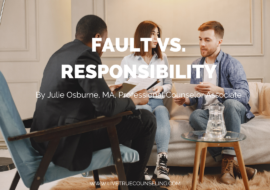Imposter Syndrome – A Different Approach
I hadn’t thought much about imposter syndrome until I was in grad school studying psychology and getting ready to start seeing clients in my internship. Grad school can only do so much to prepare a new therapist to sit with a client for the first time. As I walked into the room with my first client, I thought, “This poor person. They got me as a therapist. I don’t know what I’m doing! What if I cause some sort of irreparable damage!?! I shouldn’t be here.” While I made it through that session and many others after it, the feeling of being an imposter doesn’t go away easily. In fact, it may never go away completely.
The idea of imposter syndrome first came about in an article in 1978 by Pauline Rose Clance and Suzanne Imes. They looked at 150 high achieving women and the reasons that these women discounted their own abilities, knowledge, and strengths as reasons for their success. Imposter syndrome (they referred to it as “the imposter phenomenon”) refers to the idea that we don’t deserve whatever success we have. We feel unworthy and start to doubt our accomplishments. We’re convinced that we’re a fraud and that while we’re fooling others for now, it’s just a matter of time before we’re found out.
In the mid-1980s, Ms. Clance did further research with Gail Matthews and they discovered that out of the men and women they surveyed, around 70% have felt like imposters at some point. That 70% is still quoted today in articles about imposter syndrome, but I suspect it might actually be higher now.
Imposter syndrome today
Here’s why I think that 70% might be higher today: I hear about imposter syndrome all of the time. It’s in magazine articles everywhere. When I searched for the term on the Psychology Today website I came up with a whole list of articles, including one posted just today. It’s also frequently mentioned in podcasts. Dax Shepherd frequently talks about imposter syndrome in his Armchair Expert podcast. Clients bring it up in session regularly. I’ve struggled with it myself (more on that in a minute). There’s even a test you can take online that will tell you if you have imposter syndrome. (I will admit to being a bit baffled by the test.) It seems that everyone is talking about it.
I also feel like imposter syndrome has expanded over time and is now closely linked with identity. I’ll explain. My initial imposter syndrome gradually lessened as I settled in seeing clients in my internship. But I wasn’t done with imposter syndrome – or more accurately, it wasn’t done with me. When I graduated and started building my caseload, I had to write about myself in order to market myself as a therapist. This included identifying with a therapeutic orientation. I knew I was helpful to clients – I had great feedback from clients and supervisors during my internship – but I didn’t know what to call the type of therapy that I do. I panicked. Enter my old friend Imposter Syndrome. If I can’t brand myself as a specific type of therapist, then who am I? Can I really call myself a therapist at all? My professional identity felt empty.
This is the type of imposter syndrome that I hear about often today. Society, especially through social media and our upbringing, tell us who we should be. If we fall into the category of “man”, for instance, we learn that we should hide our emotions and only express anger. If we’re born female, we’re brought up to believe that we must play with dolls and like pink things, and that we have to dress in a certain way. We’re taught that relationships should be between a man and a woman and that there are only two people in a romantic relationship. We are taught that people are attracted to other people and that a “normal” relationship involves romance and sexual attraction. Media that surrounds us all – TV, movies, social media, music – reinforces the right way to fit into these boxes.
But what if we don’t fit into the box? What if we reject the box completely? Who are we then? That’s where imposter syndrome comes in. The pressure to feel like we have to meet all of the requirements of being a man or a woman, or to have a “normal” relationship, or to be a certain kind of therapist can be intense. And if those requirements don’t fit with who we actually are, we feel like an imposter. What if we’re actually a man who cries, or a woman who doesn’t like wearing dresses, or someone who wants to be in a consensual non-monogamous relationship or no romantic relationship at all? Trying to fit ourselves into a box that doesn’t fit who we really are means we have to pretend to be someone we’re not or feel that we have no identity at all – and it’s a horrible way to live.
Causes of imposter syndrome
In their study, Clance and Imes found two root causes of imposter syndrome in the women they surveyed. The first is having parents who designate another child as “the smart one” or “the achiever.” These women find that none of their achievements change their parents’ perspective and so they begin to believe that they aren’t smart and they downplay their achievements in their own minds. Any successes they do have are attributed to luck or a fluke, and not to their own strengths.
The second root cause they found also involved parents, but in this case the parents emphasize perfection in their children. They expect them not only to be perfect, but to be perfect without trying. One woman surveyed said that she used to hide her studying from her parents, because her mother thought that naturally brilliant people never need to study.
While I don’t doubt that there was some truth to this in 1978, and may continue to be true, I think there are other factors involved in imposter syndrome today. The idea of perfectionism comes from more than just parents today. On social media, everyone appears to be leading perfect lives with perfect bodies despite all of the perfectly prepared food they’re all eating. When we post the best of our lives, the parts of our lives that we don’t make public feel like a big secret. What if we’re found out?
I also think that as people challenge society’s view of who they should be and the box that they fit in, imposter syndrome fights back. If, for instance, you’re a man and you cry at sad movies or TV shows, you may not feel like a “real” man. As you start to explore being who you really are and building an identity out of the box for yourself, the pressure to feel like a “real” man can be intense. Imposter syndrome exists because society often tells us who we should be.
What to do about feelings of being a fraud
If you do a google search for how to overcome imposter syndrome, you’ll find a lot of advice out there (and even some TED Talks about it). Valerie Young, who is known for her work in imposter syndrome, even gives you 10 steps you can use. Experts (and “experts”, so be careful) will tell you to talk about it and share your story and that group therapy can be effective as you hear similar stories from others. They’ll tell you to change the way you think and the way you behave – to “fake it til you make it.” I found advice that even suggested telling yourself that you don’t actually feel the way that you do – and eventually you’ll come around to believing yourself.
Talking about my own experiences has been helpful for me. Sometimes talking about the anxiety you’re feeling or the feelings of despondency lead you to realize that imposter syndrome plays a part. Hearing that others are feeling the same way or have felt that way in the past can be especially validating. Talking with a therapist in a safe space and in a non-judgmental atmosphere can help you explore whatever feelings come up for you around imposter syndrome. That exploration can lead to some internal shifts in how you think about yourself and your abilities. Talking about it can be really helpful. And you might find that trying to change your thoughts or any one of Young’s 10 steps works for you. “Fake it til you make it” might be the key for you.
But here’s another thought. What about instead of trying to convince yourself that you’re not a fraud, that instead you work toward being okay with who you are? No one is brilliant or perfect all of the time. Not every therapist knows their theoretical orientation right out of the gate. Not every woman wants to wear a dress. Some men express emotions freely, wear pink dresses, wear makeup when they feel like it, and some people who identify as a man don’t even have a penis. Sometimes we’re not going to fit into society’s box or someone else’s idea of who we should be. Wouldn’t it be nice if we got to decide who we are and got to be that person without the pressure of having to be something we’re not? Imposter syndrome wouldn’t exist anymore.
All that said, I know that it is SO much easier to talk about that idea than to put it into practice. We face immense pressure to conform and to be brilliant right out of the gate without getting any time to learn. We’ve been taught from a young age who we should be and that often becomes ingrained in us. This is where therapy can really help. Your therapist’s office may be the first (and maybe for a while the only) place where you feel like you can truly be yourself. It’s a safe space where you can explore who you are and begin to take steps to live a life that feels real to you. You don’t have to be perfect. You don’t have to be who someone else tells you to be. In therapy, you can learn to be you.
This is the way forward that has resonated with me in my own feelings of imposter syndrome. As a therapist, I’m never going to be in a place where I know everything and have everything figured out. My process of learning and exploring will continue for the rest of my career. Once I remembered that I am an effective therapist, even if I didn’t know what to call myself at first, I felt a relief from the pressure of feeling like I have to be someone that I’m not. There are definitely times when I have a challenging client and those feelings of being a fraud come creeping back, but I don’t let them take over anymore. You don’t have to either.
References/Further Reading:
Apter, T. (2019, November 7). Imposter Syndrome. Retrieved November 7, 2019, from https://www.psychologytoday.com/us/basics/imposter-syndrome.
Clance, P. R., & Imes, S. A. (1978). The imposter phenomenon in high achieving women: Dynamics and therapeutic intervention. Psychotherapy: Theory, Research & Practice, 15(3), 241.
Gravois, J. (2007, November 9). You’re Not Fooling Anyone. Retrieved November 7, 2019, from https://www.chronicle.com/article/Youre-Not-Fooling-Anyone/28069.
Leonard, J. (2018, May 4). Impostor syndrome: Symptoms, types, and how to deal with it. Retrieved November 7, 2019, from https://www.medicalnewstoday.com/articles/321730.php.
Sakulku, J. (2011). The impostor phenomenon. The Journal of Behavioral Science, 6(1), 75-97.
Young, V. (2018, April 28). 10 Steps You Can Use to Overcome Impostor Syndrome. Retrieved November 7, 2019, from https://impostorsyndrome.com/10-steps-overcome-impostor/.
Jenny Larson loves her work as a therapist at Live True Counseling and as a Volunteer Counselor at William Temple House. When not seeing clients, she can be found reading psychology books and celebrity memoirs, watching bad (good) 80s movies, and sewing or baking. While self-identified as a cat person, she also has a fondness for dogs and other animals.










Write a Comment